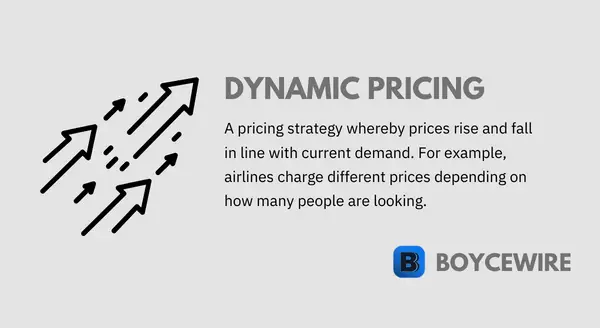Dynamic Pricing: Definition, Pros, Cons & Examples

What is Dynamic Pricing?
Dynamic pricing is where the price of a good or service constantly fluctuates based on current demand. In other words, if there are many customers wanting to buy, prices increase to reflect this. At the same time, if demand falls significantly, prices adjust downwards to attract customers.
Dynamic pricing is commonly used by online shopping firms. Prices change through an algorithm that looks at current trends in demand and constantly changes the price based on such.
If we look at airlines for example. Ticket prices can vary day to day and month to month. For instance, there may be a lot of customers looking at and buying tickets. In that case, the algorithm kicks in and starts to increase the price. At the same time, if nobody is looking at tickets, prices may fall in order to attract customers.
Key Points
- Dynamic pricing is a pricing strategy where firms constantly alter prices depending on recent levels of demand.
- When recent demand is high, dynamic pricing will increase prices. When demand is low, then the dynamic pricing will reduce prices to attract customers.
- Dynamic pricing allows businesses to respond to changing market conditions and maximize revenue by charging higher prices during periods of high demand and lower prices during periods of low demand.
Dynamic Pricing Examples
Airlines
When airlines first release tickets onto the market, the level of demand is somewhat unknown. They may be able to rely on existing trends and previous sales history to help determine a reasonable price. In addition, they can check how quickly tickets sold for similar flights and then price accordingly.
Profit maximization is important to airlines, so if they have priced tickets too low, dynamic pricing can increase to fit in line with demand and boost profits. No company wants to sell their goods at a price that is way under the market value, which is why dynamic pricing allows firms to correct this where necessary.
Take the example below, of a flight from London Heathrow to JFK, New York. Within a day, the price increases by £8 as it adjusts to an increase in demand.

Airbnb
Airbnb is a business that rents out people’s homes when they do not need them. In return, a tourist or visitor to the area pays a fee to use the house or apartment. The company acts as an intermediary between the homeowner and the customer. Essentially, it’s similar to a hotel.
Dynamic pricing is used by Airbnb to maximise the amount that both homeowners and themselves make. This works slightly different from airlines as the price cannot change based on direct demand. Instead, prices may rise as demand for other accommodation increases.
For instance, there may be 50 Airbnb apartments available to rent in New York during the first week of July. They are selling out quickly, with 40 of them already rented out. That sends a signal that there is high demand in the area, so Airbnb will use dynamic pricing to increase the price of the other 10.

Amazon
Some goods at Amazon are not only dynamically priced to account for demand, but also competitors’ prices. So when the price of a PlayStation game goes down at GameStop, the prices react dynamically in order to compete.
The Amazon algorithm is very complex and it considers a number of factors. Not only is demand an important aspect, but so too of competition, as well as customer intent. That may mean that prices are dynamically changed downwards if the good is left in the basket for a prolonged period of time.
Obviously, the true nature and complexity are kept secret by Amazon, but it is not a secret that prices constantly change on their site throughout the day.
Uber
The Uber dynamic pricing mechanism is also another complex example. Not only do prices increase or decrease with demand, but also consider factors such as traffic, time and distance, and even the number of drivers available.
There are also other variables that look at potential peak demand. For instance, after-work rush hour, weekends, and even festivals and other big events, all contribute to the algorithms’ dynamic pricing.
So even though you may pay $10 for your daily ride, this could increase to $20 because Beyoncé is in town.
Advantages of Dynamic Pricing
1. Increase in Sales
By using dynamic pricing, prices not only increase, but they also fall. So when demand is low, prices fall in order to attract demand and sales. If prices were set constantly at a higher rate, the number of sales may not be so high.
For example, airliners may set the price of a ticket at $200. That may capture half of the demand, but not the customers who are unwilling to pay that much. Or, it may capture last-minute demand, but not those who are willing to book 9 months in advance.
By using dynamic pricing, prices can fluctuate with demand and therefore maximise sales as well as profits.
2. Profit Maximisation
As firms are able to increase sales, they are also able to maximise profits. For instance, a taxi driver may find they are getting a lot of custom between 5 pm and 6 pm. In turn, prices are dynamically changed to reflect the peak in demand.
However, between odd hours such as 2 pm and 3 pm, demand is not so high. Drivers may be left without work, so reduce prices in order to attract customers.
By doing so, they are able to capture the customers who are willing to pay more due to peak hours, as well as those who are only willing to pay less during non-peak. At the same time, dynamic pricing may depend on a company by company basis. Some firms may be seeing a higher level of demand, so increase prices even during non-peak hours.
As a result, profits are maximised as they follow demand and extract the maximum price out of customers.
3. Increased Competition
Another advantage of dynamic pricing is increased competition. Companies such as Amazon use it to compare prices to competitors and reduce them in order to compete. That also means cheaper prices for the consumer.
During peak periods, prices may dynamically change due to greater demand. However, demand for one company may be higher than another. So prices may not go up so dramatically at the company that is experiencing lower demand. That helps to balance out the market as the excess demand can flow to businesses that are not so busy.
At the same time, when companies dynamically change prices upwards, it shows that it is making extra profit, and customers are willing to pay such. That sends a signal to competitors or potential competitors that there are profits to be made. This could lead to new entrants to join the market.
Disadvantages of Dynamic Pricing
1. Price Wars
Although not necessarily bad for customers, price wars may result as firms dynamically price based on competitors. For instance, Amazon frequently changes its prices to ensure that it’s the cheapest on the market. Whilst Amazon has the financial muscle to do so, it can prove fatal in markets where competition is more evenly balanced.
If we look at food retailers such as Walmart, Whole Foods, or Target, a price war can prove costly. Price margins are already extremely tight, so it could lead to falling profitability.
2. Annoyed Customers
Dynamic pricing is difficult to hide. When you look to buy something at 10 in the morning and then the price doubles by 3 in the afternoon, it is obvious what is happening.
Some critics say that dynamic pricing is a form of price gouging. This is where prices increase and take advantage of a surge in demand.
Customers are inevitably frustrated and annoyed that they are paying more for the same product or service. It has been commonplace in the airline industry, with customers largely accepting the practice. However, when it comes to products such as shoes or electrical goods, it can be frustrating.
When you put something into your basket and come back a couple of hours to find it has increased in price by $10; it is rational to feel some level of annoyance. In turn, this can put customers off in dealing with certain companies.
3. Potential Lost Sales
Dynamic pricing can be fairly obvious. It is for this reason that customers tend to become annoyed and look elsewhere instead. Peak periods may see prices rise dramatically, whilst competitors who don’t use dynamic pricing, provide the customer with a cheaper alternative.
In turn, this could create greater brand loyalty with competitors who don’t use unfavourable tactics. At the same time, customers may add a product to their basket to buy later, but see the price has gone up. So rather than purchasing it like originally intended, they may go elsewhere or not buy the product at all.
FAQs
Dynamic pricing is a pricing strategy where prices are adjusted based on changing market conditions, such as demand, supply, and competition.
Dynamic pricing works by using algorithms to analyze market conditions and adjust prices accordingly. Prices may be increased during periods of high demand or decreased during periods of low demand.
Although dynamic pricing effectively discriminates based on factors such as time or location, it is still legal. This is because it is not discriminating based on a protected characteristic such as race, sex, gender, or age.
Airlines are a classic example of dynamic pricing. They often change the prices depending on factors such as how many people are viewing the flights to how many customers are buying similar flights to similar destinations.
There are many benefits of dynamic pricing, some of them include:
1. Increase in Sales
2. Profit Maximisation
3. Increased Competition
About Paul
Paul Boyce is an economics editor with over 10 years experience in the industry. Currently working as a consultant within the financial services sector, Paul is the CEO and chief editor of BoyceWire. He has written publications for FEE, the Mises Institute, and many others.

Further Reading
 Why Free Markets are Important - According to the Collins Dictionary, a free market is an economic system that allows supply and demand to regulate prices,…
Why Free Markets are Important - According to the Collins Dictionary, a free market is an economic system that allows supply and demand to regulate prices,…  Scarcity: What it is in Economics, Examples & Causes - Scarcity refers to the limit upon resources that we have which force economical decision making.
Scarcity: What it is in Economics, Examples & Causes - Scarcity refers to the limit upon resources that we have which force economical decision making.  Corporate Governance: Definition, Pillars & Format - Corporate governance is the set of rules and relationships which seek to align the interest of the board of directors,…
Corporate Governance: Definition, Pillars & Format - Corporate governance is the set of rules and relationships which seek to align the interest of the board of directors,… 